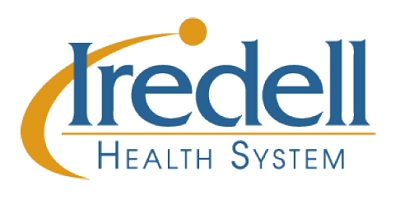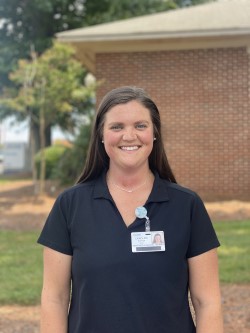
Special to Iredell Free News
One minute you’re watching your child play their favorite sport. Then, while cheering them on, you see them grab their ankle and fall.
As the coaches and the medical staff rush over to them, your worried thoughts kick in — “Is my child OK? Do I need to take them to the doctor? Are they out for the season? What can I do to help?”
While you may enjoy watching your child have fun and reap the health benefits from participating in sports, it’s second nature to have concerns about their safety while playing.

“Being involved in sports is a great way for your child to stay physically active while doing something they love, but it is also a risk for injury. Our bodies tell us through pain that it may need rest from the demanding physical activity, or that it may need extra nourishment,” said one of Iredell Health System’s certified athletic trainers, Caroline Sawyer (MS, LAT, ATC).
Sawyer works for Iredell Health System at Iredell Rehab at Mooresville and is the certified athletic trainer for South Iredell High School.
“It is an athletic trainer’s duty to prevent, evaluate, treat, and rehabilitate your child’s sports injuries. We are there to keep your athlete safe while they are enjoying their sport and doing what they love,” she said.
By knowing the causes of sports injuries and how to prevent them, you can help your child stay safe and play safe.
Acute Sports Injuries
Acute injuries are a common type of sports injury in kids and teens. This type of injury occurs suddenly and is usually associated with a traumatic event like being tackled in football or getting hit with a baseball while batting.
According to Sawyer, acute injuries include muscle strains, ligament sprains, bone fractures, concussions, contusions, and dislocations, among others.
One of the most common injuries Sawyer sees in young athletes is ligament sprains, normally in the ankle or knee.
Overuse Sports Injuries
“Another common type of sports-related injury, overuse injuries, are caused by the repetitive dynamics of the body’s motions like running, jumping, or throwing,” said Sawyer.
If your child plays sports year-round, they may be susceptible to overuse injuries as a result of repetitive stress.
Examples of overuse injuries include stress fractures and tendonitis. A runner suffering from shin splints, a pitcher with little league elbow, or a swimmer that has swimmer’s shoulder also serve as examples of overuse injuries.
Overuse injuries can be caused or aggravated by not resting or not getting enough rest, improper body movement, and increased stress load.
Preventing Sports Injuries
Proper conditioning
According to Sawyer, one of the main reasons sports injuries happen is from improper conditioning.
Engaging in an activity your child is not properly conditioned for may cause injury. When muscles are not used regularly, they weaken so injury may occur when your child attempts intense physical activity beyond their means.
“Limited flexibility in the muscles leads to a limited range of motion in the joints. It decreases the elasticity of the muscles,” said Sawyer.
To avoid this, encourage your child to engage in regular exercise, even in the off-season.
“If your child is not physically active already, encourage them to get moving, even if it’s just taking a lap around the neighborhood. If your child goes to the first tryout, workout, or practice without being properly conditioned, they will not perform like they should and may even get hurt,” said Sawyer.
Stretching, proper warm-up exercises, and cool-down exercises are also helpful in preventing sports injuries.
“If the body is not properly stretched, it can decrease mobility. Tight muscles can restrict physical movements and decrease performance as well as increase injury,” said Sawyer.
“Simple stretches can improve the body’s flexible state and heighten performance,” she added.
Wear the right gear
To reduce the risk of injury, it’s important to ensure your child is wearing the right gear.
According to Sawyer, you should make sure your child has the proper equipment, that they are actually wearing it, and that it fits properly.
Sawyer uses shoes as an example of the need for proper equipment.
“Everyone wears shoes, and it’s not a one-size-fits-all. Our body is like a long-linked chain. If we are not wearing the right shoes for us, or if they do not fit properly, it’s going to affect our entire body from our knees, to our hips, and so-forth up the body,” said Sawyer.
If your child has a previous history of ankle sprains or knee injuries, make sure they wear their ankle braces or knee braces during physical activity.
Additionally, in contact sports like football, make sure your child’s helmet fits properly to reduce the risk of head injury.
Healthy eating and hydration
Promoting a healthy diet for your young athlete is crucial.
“What you put into your body is what you are going to get out of it. So the quality of what an athlete eats is important. Myplate.gov is a good resource to review healthy eating habits for you and your child,” said Sawyer.
Sawyer mentioned that it is common for an athlete to show up to summer workouts without eating or drinking beforehand, lowering their energy level. This decreases their athletic performance because they are either too dehydrated or malnourished to put in the necessary work for their sport.
“As long as the athlete is fueled with quality food and fluid that follows macronutrient recommendations for their daily dietary needs, they should be able to perform to their abilities without fully exhausting themselves,” said Sawyer.
You should also make sure your child is drinking the right amount of water to reduce the risk of injury.
According to Sawyer, your child’s body weight, divided by two, is how many ounces of water they should be drinking per day. Electrolytes and sports drinks are a great way to rehydrate your child if they are dehydrated after physical activity.
After a Sports Injury
If your child does get injured while playing sports, taking care of the injury and knowing when to seek medical attention are important steps in the healing process.
Mild strains and sprains can benefit from initial treatment at home. Sawyer recommends using the POLICE method. The POLICE acronym stands for:
• Protection: Firstly, you should rest the injured joint, ligament, or muscle, reduce activity, and use crutches or braces if needed.
• Optimal Loading: This describes how much pressure or force your child can put on the injured area without pushing through the pain. As prolonged rest can cause stiffness, optimal loading is doing as much as your child feels comfortable doing.
• Ice: Put ice on your child’s injury to keep the swelling down. Use ice for 20 minutes at a time, four to eight times a day.
• Compression: Compress the injured area to keep swelling down and support the area. You can use elastic wraps, air casts, splints, or boots.
• Elevation: Keep your child’s injured area elevated with a pillow above the level of their heart to reduce swelling.
“If your athlete does not progress in a week, or if the injury is emergent, like a physical deformity, seek medical attention,” said Sawyer.
According to the American Academy of Pediatricians, you should take your athlete to see a provider for:
• Symptoms that do not go away after rest and home treatment
• Any condition that affects training or performance that has not been given a diagnosis or has not been treated
• Any condition that may be a risk to other teammates or competitors
About Iredell Health System
Iredell Health System includes Iredell Memorial Hospital; Iredell Mooresville; Iredell Home Health; Iredell Wound Care & Hyperbaric Center; Community and Corporate Wellness; Occupational Medicine; the Iredell Physician Network and more. Iredell Memorial Hospital is the largest and only nonprofit hospital in Iredell County. The comprehensive healthcare facility has 247 beds; more than 1,700 employees; and has 260 physicians representing various specialties. Centers of excellence include Women’s and Children’s; Cardiovascular; Cancer; Surgical Services and Wellness & Prevention. The Health System’s newest campus, Iredell Mooresville, is home to the area’s only 24-hour urgent care facility, as well as an ambulatory surgery center, imaging center, rehabilitation services, and physician practices. The mission of Iredell Health System is to inspire wellbeing. For a comprehensive list of services and programs, visit www.iredellhealth.org.



